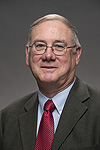IARC: "One lab" in practice
 |
|
Bob Kephart
|
Bob Kephart, head of the Illinois Accelerator Research Center, wrote this column.
The Illinois Accelerator Research Center (IARC) is a bold new initiative for Fermilab. It is intended to demonstrate how Fermilab expertise and excellence in accelerators can be valuable to industry and the economy. Thus, IARC will leverage the taxpayer's investment in science to create new accelerator-based industries, companies and jobs. The IARC facility was made possible by an unusual partnership with both U.S. Department of Energy (DOE) and the Illinois Department of Commerce and Economic Opportunity providing funding for construction.
Currently, only a handful of Fermilab staff work full time on IARC. However, we are supported by a much larger team across the lab, making the creation of IARC truly a "one lab" effort. A FESS team led by Rhonda Merchut has done a great job of completing the construction of the state-funded Office, Technical and Engineering (OTE) building, delivering an architecturally beautiful and energy-efficient building on time and within budget. Following beneficial occupancy in May, the OTE effort is now focused on the DOE-funded outfitting, including underfloor wiring, partitions and furniture, and is paced by available funding during the ongoing FY15 budget continuing resolution.
Nevertheless, a Core Computing Division team is nearing completion of its work on the network services for IARC's third floor; the contract is out for the first phase underfloor wiring; and bids were just received for the third-floor partitions and furniture to support OTE's first occupants in the spring of 2015. In parallel, Steve Dixon in FESS leads the effort to refurbish the CDF Heavy Assembly Building (HAB) for its new life as part of IARC. In July a PPD team led by Jonathan Lewis completed the Herculean task of removing 3,000 tons of CDF experimental equipment and handed over the keys to HAB to Rich White. He is the building manager for IARC's new landlord, the Accelerator Division, an organization uniquely qualified to install, review and commission new accelerators.
Currently, the HAB refurbishment is in full swing. The 50-ton crane and water cooling systems in HAB have been refurbished, all new electrical switchgear has replaced 30-year, obsolete systems, new energy-efficient (and quiet) LED lighting has been installed in the high bay, overhead roof beams have been cleaned and painted, and the upper-level floors of the heavy-assembly area have been cleaned and resealed. Work packages in progress will install new rooftop HVAC units and controls for the high bay, refurbish the bathrooms, restore third-floor office and technical spaces, and install an elevator and other features to make the building Americans with Disabilities Act-compliant and to refurbish the deep pit. All this effort is aimed at making HAB ready for first use by industry in the late summer of 2015.
Beyond the many moving pieces that make up the IARC physical plant, there are even more elements that make up the business model for how IARC will operate. More on this in a subsequent article, but suffice it to say that a small team guided by the lab director and COO has been hard at work and relying on a rich "one lab" alphabet soup of support organizations including OPTT, the Legal Office, FSO, FRA and outside business consultants from UChicagoTech to create a viable business model for this unusual new center work that will appeal to our many stakeholders.
The most pressing question is "If we build it, will they come?" As we engage external partners through IARC, how will we fill gaps in resources to meet our ambition? Progress over the next year will give us a good sense of the answers to these questions. We have received strong words of encouragement from the highest levels of DOE and other partners, and it is encouraging that, even before a formal program announcement, IARC has been approached by more than 20 industries interested in possible projects with Fermilab. Stay tuned!
|